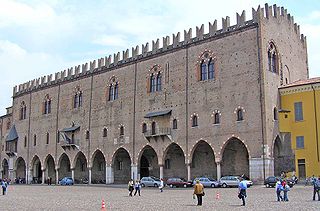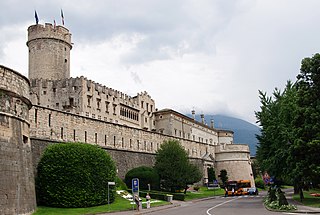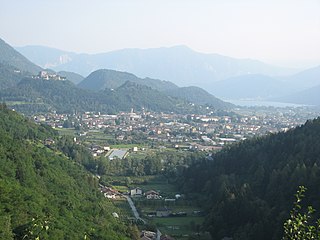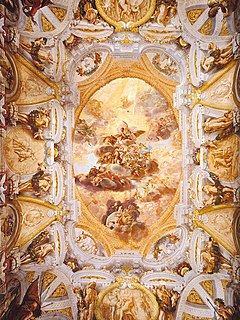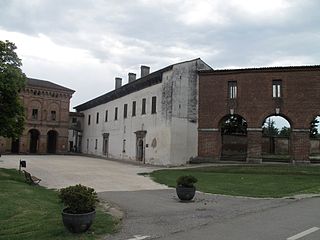Coordinates: 46°03′47″N11°06′49″E / 46.063169°N 11.113663°E

A geographic coordinate system is a coordinate system that enables every location on Earth to be specified by a set of numbers, letters or symbols. The coordinates are often chosen such that one of the numbers represents a vertical position and two or three of the numbers represent a horizontal position; alternatively, a geographic position may be expressed in a combined three-dimensional Cartesian vector. A common choice of coordinates is latitude, longitude and elevation. To specify a location on a plane requires a map projection.
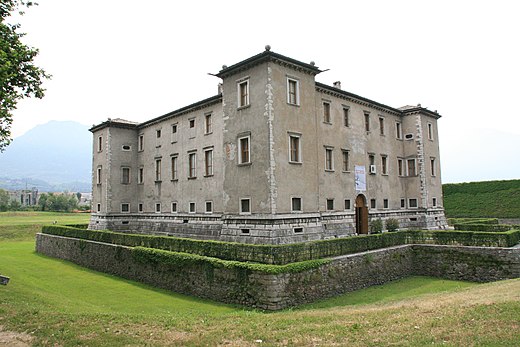
Palazzo delle Albere is a Renaissance villa-fortress in Trento, northern Italy. It was built during the 16th century by the Madruzzo family of prince-bishops of Trento. It takes its name (meaning "Palace of the Trees") from the rows of poplars that once led to the castle; it is surrounded by a park, now smaller than once because it is crossed by the Brenner Railway and partly occupied by the Trento Monumental Cemetery. It has a square plan, with four square, 6 m-wide and 20 m tall corner towers, surrounded by a ditch.

Trento is a city on the Adige River in Trentino-Alto Adige/Südtirol in Italy. It is the capital of the autonomous province of Trento. In the 16th century, the city was the location of the Council of Trent. Formerly part of Austria and Austria-Hungary, it was annexed by Italy in 1919. With almost 120,000 inhabitants, Trento is the third largest city in the Alps and second largest in the Tyrol.

Italy, officially the Italian Republic, is a European country consisting of a peninsula delimited by the Italian Alps and surrounded by several islands. Located in the middle of the Mediterranean sea and traversed along its length by the Apennines, Italy has a largely temperate seasonal climate. The country covers an area of 301,340 km2 (116,350 sq mi) and shares open land borders with France, Slovenia, Austria, Switzerland and the enclaved microstates of Vatican City and San Marino. Italy has a territorial exclave in Switzerland (Campione) and a maritime exclave in the Tunisian sea (Lampedusa). With around 60 million inhabitants, Italy is the fourth-most populous member state of the European Union.

Cristoforo Madruzzo was an Italian Roman Catholic cardinal and statesman. His brother Eriprando was a mercenary captain who fought in the Italian Wars.
In the Great Hall, on the second floor, were once frescoes celebrating emperor Charles V's deeds. Still visible are instead the depictions of the 12 months. The third floor has also kept numerous Renaissance frescoes, depicting imaginary landscapes with ruins and castles, as well as the seven Liberal arts, the four Cardinal virtues and the three Theological virtues.
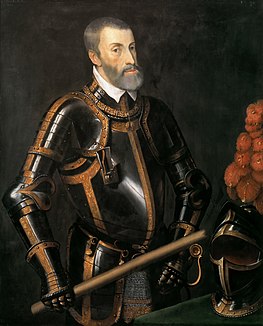
Charles V was Holy Roman Emperor (1519–1556), King of Germany (1520-1556), King of Italy (1530-1556), King of Spain (1516-1556), King of the Indies (1521-1556), Lord of the Habsburg Netherlands (1506–1555), and head of the House of Austria (1519-1556). Charles V revitalized the medieval concept of the universal monarchy of Charlemagne and travelled from city to city, with no single fixed capital: overall he spent 28 years in the Habsburg Netherlands, 18 years in Spain, and 9 years in Germany. After four decades of incessant warfare with the Protestants, the Ottoman Empire, and the Kingdom of France, Charles V abandoned his multi-national project with a series of abdications between 1554 and 1556 in favor of his son Philip II of Spain and brother Ferdinand I of Austria. The personal union of his European and American territories, spanning over nearly 4 million square kilometres, was the first collection of realms to be defined as "the empire on which the sun never sets".
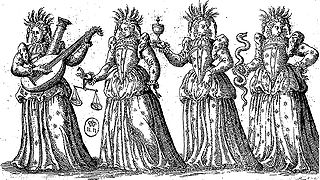
Four cardinal virtues were recognized in the Bible, Old Testament, classical antiquity and in traditional Christian theology:
Theological virtues are virtues associated in Christian theology and philosophy with salvation resulting from the grace of God. Virtues are traits or qualities which dispose one to conduct oneself in a morally good manner. Traditionally they have been named Faith, Hope, and Charity, and can trace their importance in Christian theology to Paul the Apostle in 1 Corinthians 13, who also pointed out that charity is the most important.
According to legend, it was connected by a secret tunnel to the city's cathedral, which was used by the prince-bishops move unseen between them. [1]

Trento Cathedral is a Roman Catholic cathedral in Trento, northern Italy. It is the mother church of the Roman Catholic Archdiocese of Trento, and until 1802, was the seat of the Bishopric of Trent. It was built over a pre-existing 6th-century church devoted to Saint Vigilius, patron saint of the city.
From 1987 to 2011, Palazzo delle Albere was the seat of the Museum of Modern and Contemporary Art of Trento and Rovereto (MART).

The Museum of Modern and Contemporary Art of Trento and Rovereto (MART) is a museum centre in the Italian province of Trento. The main site is in Rovereto, and contains mostly modern and contemporary artworks, including works from renowned Giorgio Morandi, Giorgio de Chirico, Felice Casorati, Carlo Carrà and Fortunato Depero. Fortunato Depero's house in Rovereto is also part of the Museum.






